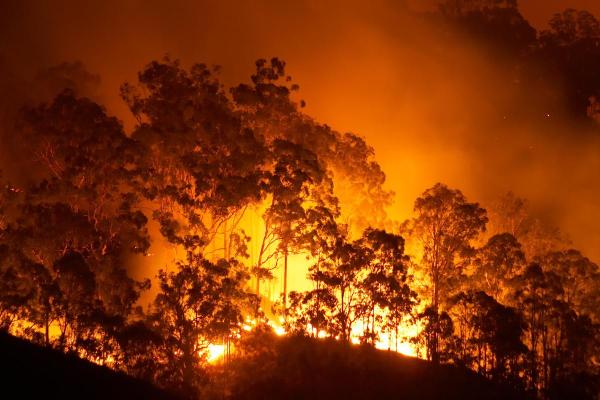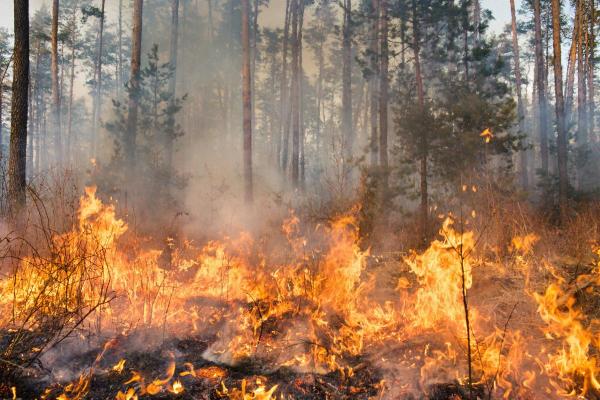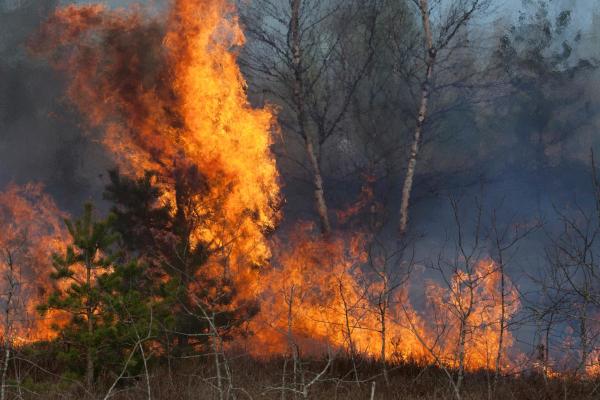What is a forest fire?


Forest fires, also known as wildfires, are natural or human-induced infernos that ravage vast expanses of wooded areas, leaving destruction and ecological impacts in their wake. These fires are a formidable force of nature, capable of spreading with astonishing speed and intensity, fueled by the abundance of wood, leaves, and dry vegetation. While some forest fires stem from natural causes like lightning strikes or volcanic eruptions, the majority are triggered by human activities, either accidental or deliberate.
The following article by thedailyECO explores the nature of forest fires, their causes, and their connection to climate change.
What are forest fires?
Forest fires present a significant threat to the natural environment, especially within forested areas. The abundance of wood and leaves in these regions allows the fire to spread rapidly, making it challenging to control. Unlike fires in urban settings, accessing forest fire sites is more difficult due to their remote locations and lack of water sources, which adds to the complexity of firefighting efforts.
The impact of forest fires on the environment is profound, particularly when they occur in ecologically valuable forests. These areas often support diverse plant and animal species, and the fires can lead to the complete destruction of entire ecosystems within a short period. Restoration and recovery after such fires are lengthy processes, as it takes decades for replanted trees to grow and return the area to its former state.
To protect our forests and prevent such devastation, it's crucial to raise awareness about the importance of forest preservation and implement preventive measures. It is only by understanding this delicate balance that we can reduce the occurrence and impact of forest fires, ensuring that these natural wonders continue to flourish for generations to come.
To gain a better understanding of the various types of forests, make sure to read this additional article.

How do forest fires occur?
Forest fires can arise from various causes, with both natural forces and human actions playing significant roles. While natural causes like high temperatures and lightning strikes are relatively uncommon, the leading cause of forest fires can be attributed to human activities.
Human actions, whether inadvertent, such as leaving a bonfire unattended or discarding a lit cigarette carelessly, or deliberate, like the acts of arsonists or driven by economic interests, pose a substantial threat to forest ecosystems.
The degree of dryness in the forest stands as a crucial factor when it comes to the outbreak of fires. As a result, most forest fires tend to occur during the summer season. Several contributing factors converge during this period. The proliferation of scrubland vegetation after the spring creates ample fuel for the fire to spread swiftly.
Additionally, the combination of scorching temperatures and arid environmental conditions further enhances the combustibility of the vegetation. Consequently, the majority of forest fires transpire during the hot months, particularly in the peak of summer.

Relation between forest fires and climate change
Forest fires and climate change are deeply interconnected, and their relationship is a cause for concern. Climate change exacerbates the frequency and intensity of forest fires, while forest fires, in turn, contribute to climate change through various mechanisms.
Rising global temperatures, driven by increasing greenhouse gas emissions, lead to drier conditions in many regions. Elevated temperatures evaporate moisture from vegetation and soil, making forests more susceptible to ignition and promoting fire spread.
Warmer temperatures and earlier springs result in longer fire seasons. With more extended periods of dry and hot weather, the likelihood of fires occurring and spreading intensifies.
Climate change leads to shifts in precipitation patterns, causing prolonged droughts in certain areas. Drier conditions contribute to the buildup of flammable materials, increasing the potential fuel for fires.
Climate change can facilitate the spread of invasive plant species that are better adapted to warmer conditions and have higher flammability, thus increasing the risk of fires.
On the other hand, forest fires play a significant role in contributing to climate change through their impact on the global carbon cycle. When a forest fire occurs, large amounts of carbon stored in trees, vegetation, and soil are released into the atmosphere in the form of carbon dioxide (CO2) and other greenhouse gases. This release of greenhouse gases intensifies the greenhouse effect, trapping heat in the Earth's atmosphere and leading to global warming.
You might find this other article intriguing as it delves into the causes and effects of deforestation.
How to prevent forest fires
Preventing forest fires requires a collective effort from individuals, forest maintenance teams, institutions, and society as a whole. There are several crucial measures that can be implemented to mitigate the risk of forest fires:
- Every person visiting the forest must act responsibly and avoid activities that could lead to fire outbreaks. This includes refraining from making bonfires or barbecues in natural settings, properly disposing of cigarette butts, and not leaving behind bottles or glass that could act as a magnifying glass and ignite fires.
- Forest maintenance teams play a vital role in preventing fires. They should not only monitor potential fire outbreaks but also engage in proactive forestry prevention work. Removing dry vegetation during the summer and clearing low scrub forests can help reduce the fuel available for fires to spread.
- Government institutions need to take decisive action against forest fires. Laws must be enacted to protect burned forests from being converted into developable land after a fire. Additionally, thorough investigations and appropriate sanctions should be imposed on arsonists to deter such criminal activities.
- Raising awareness and educating the public about the dangers of forest fires is crucial. By understanding the consequences of their actions, people are more likely to avoid risky situations and act responsibly when in forested areas.
Through the combined efforts of responsible individuals, diligent forest maintenance teams, proactive institutions, and an informed and aware society, the prevention of forest fires can be significantly improved.
If you are interested in learning more about how to prevent forest fires, be sure to check out this other article.
If you want to read similar articles to What is a forest fire?, we recommend you visit our Environment (other) category.











